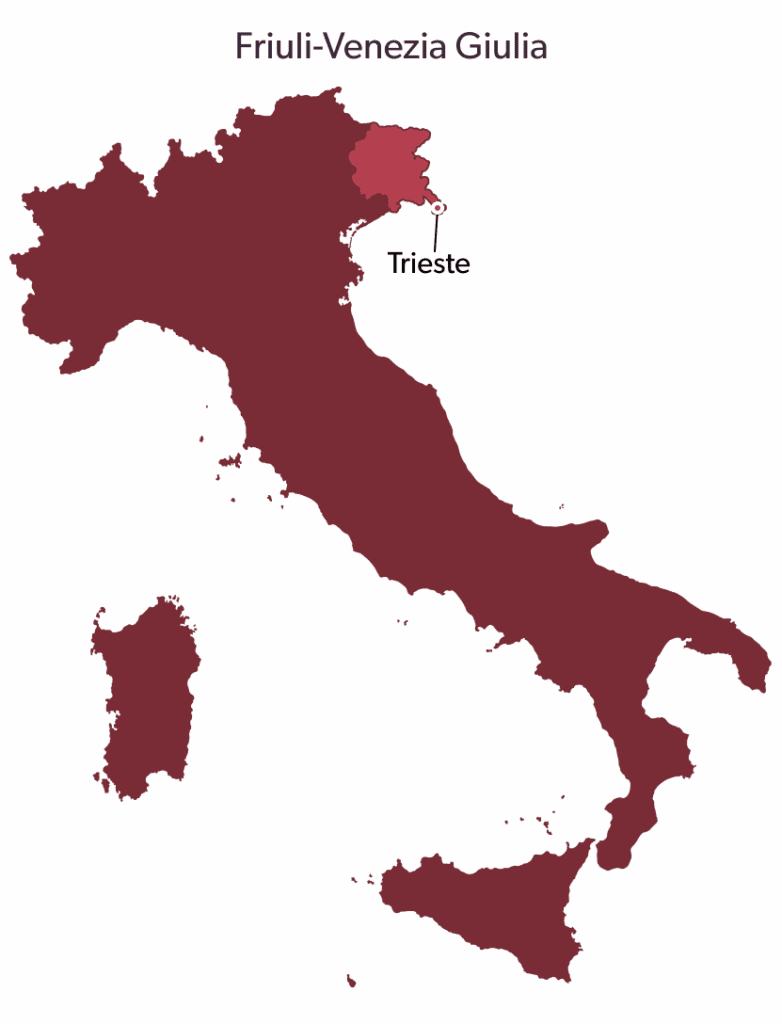Gorizia is a city and province located in the region of Friuli-Venezia Giulia in the north eastern edge of Italy along the Slovenian border. The city is often referred to as the entryway from Italy into Central Europe.
For the beauty of its buildings, Gorizia was called the “Austrian Nice” by the Habsburg aristocracy. Gorizia is a small and pleasant city, where it’s royal past still lives on in the palaces and beautiful gardens found throughout the city, including the splendid Viatori, also known as the Azalea garden.
Gorizia is also a symbol of the troubled history of the twentieth century in Europe. Formerly a town in the territory of the Austro-Hungarian Empire until it was annexed to Italy in 1918 after WWI, Gorizia has been witness to many dramatic events involving Italy’s eastern border during Fascism and the Second World War.
During WWII the city was split in two parts, with a section of Gorizia being part of the former Yugoslavia. The territory was divided by the so-called “wall of Gorizia”, which was erected in Piazza Transalpina and became one of the symbols of the political-ideological separation between Western and Eastern Europe during the years of the Cold War. The border wall was demolished with the entry of Slovenia into the European Union in 2004 and today the borderline is a symbol of unity between the two nations. Piazza della Transalpina is divided between the municipalities of Gorizia and Nova Gorica, in Slovenia, where the border wall once stood there is now a row of bricks to indicate the border, making it possible to simultaneously be in two different countries at once.
Throughout the city, there are many monuments and places of historical and artistic interest that are worth visiting, some include:
Piazza della Vittoria
Piazza Vittoria, originally a grassy clearing called “Travnik” (meadow), which was overlooked by some stately buildings and some artisan shops, has been considered a center of city live since the eighteenth century, the period of economic growth for the city.
The main building that dominates the square is the church of Sant’Ignazio, an imposing baroque structure built by Jesuits, present in Gorizia since 1615. At the center of the square is the Neptune Fountain and the Tritons, made in 1756 by the Paduan Marco Chiereghin designed by Nicolò Pacassi (a Gorizian architect much appreciated by the Habsburgs and designer of the Schönbrunn palace). Many historical events took place in Piazza Vittoria: on September 20, 1938, Benito Mussolini made a speech from the prefectural building to a large crowd of Gorizian citizens as well as the tragic suicide of of the 23-year-old Gorizia philosopher Carlo Michelstaedter , a leading figure in the European philosophical landscape of the early twentieth century in October 1910.
Via Del Rastello
One of the most picturesque streets of the city directly connected to Piazza Vittoria. Its name comes from the gate that, during the night, during the Middle Ages, separated the citadel from the countryside. It has long been a characteristic pedestrian street and for most of the twentieth century it was the economic center of Gorizia.
The Synagogue of Gorizia
Located in Gorizia’s ancient Jewish quarter, where the Jewish Community of Gorizia settled in the 1600s. The synagogue is the most representative building of the city’s Jewish history, the Synagogue also houses the educational museum of Little Jerusalem on the Isonzo, where it is possible to learn about the Jewish community of Gorizia, its traditions and its links with the great Central European culture.
Gorizia Castle
Dating back to the 11th century, the Gorizia Castle is the ancient heart of the city. Located on the hill overlooking the town, it offers a spectacular panoramic view of Gorizia and the surrounding area.
Its current appearance does not exactly reflect the original one as it was demolished by the Venetians for defense reasons, today only the foundations remain visible inside the Lanzi court. The castle reflects the evolution that took place between the 13th and 16th centuries with the addition of buildings and defensive structures. The castle changed owner several times, passing from the hands of the counts of Gorizia, the Church of Aquileia, and finally to the Habsburg dynasty.
Palazzo Coronini Cronberg
A historic home dating back to the end of the sixteenth century. Walking through the fifteen rooms that make up the palazzo, including the room where Charles X of Bourbon died, the last king of France in 1836, visitors are transported back in time, thanks to the historic atmosphere of the rooms with seventeenth-century furnishings and luxurious decor.
An Enchanting Excursion through Gorizia’s hills
The surroundings of Gorizia offer an enchanting and relaxing landscape of rolling hills dotted with wine bars, vineyards and wineries where crisp white wines full bodied reds are produced. The hills are located on the Slovenian border, which their main center is in the Italian town Cormons. Thanks to the hilly terrain and its proximity to the the sea, the territory creates a unique microclimate ideal for the cultivation of wine.
But Gorizia’s hills are also known for their splendid landscape made of green hills covered with rows of vines that in spring are also populated with the colours of cherry trees in bloom. The hills are beautiful to discover on a Vespa to see the nature as well as the shapes of scattered houses and white villages gathered around sharp bell towers. Among the hills there is the Gorizia Karst which is the area that was the scene of many battles during the first World War, and today it stands as a testimony to that time especially with the Redipuglia War Memorial which is a monumental cemetery for fallen Italian soldiers.
Gradisca D’Isonzo
Gradisca d’Isonzo is a noble city which, beginning in the 16th century, assumed a key role in the defensive system set up by the Republic of Venice against the Turkish invasions. The Serenissima in fact fortified it powerfully, so much so that the historic center like it was enclosed in 1479 by a mighty city wall. The remarkable architectural heritage of Gradisca grew between the seventeenth and eighteenth centuries, when the transformation into the city of Principesca County of Gradisca was now underway. The four centuries of Habsburg influence have left a strong historical imprint, which today combines with a modern city filled with many restaurants and bars where visitors can taste the best wines from Friuli-Venezia Giulia, especially Isonzo del Friuli DOC wine.
Gastronomic Delicacies of the Territory
Between the Isonzo river and the Judrio rive lies the Collio DOC area, which represents one of the most prized areas for wine production in Italy. The quality of the wines produced is thanks to a perfect microclimate for to grow wine due to the mild climate, the slopes and the proximity to the sea. All this allows the cultivation of nearly two thousand hectares of specialized hillside vineyards that produce excellent quality wines such as Pinot Grigio, Pinot Bianco, Friulano, Sauvignon, Ribolla Gialla, Cabernet Franc, Cabernet Sauvignon, Merlot and Collio Bianco
The area is also known for other delicacies such as the Cormòns ham and the red chicory “Rosa di Gorizia”. Moreover, thanks above all to the meeting between the culinary traditions of Austrian, Friulian and Slovenian cuisine, we find dishes such as goulash, blecs, zlikrof (a kind of stuffed ravioli), bread dumplings, kipfel ( fried dough similar to gnocchi), repa garba and other typical sweets such as putizza, pinza, strudel, krapfen and palacinke (an omelette that can be sweet or savory). These local products can be found in the restaurants of the province as well as at village festivals that animate the landscape from May in September.

